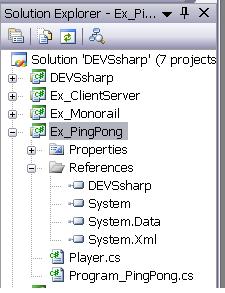
|
DEVSsharp\DEVSsharp.sln, you can find Ex_PingPong
project in which there are two source files: Player.cs
and Program_PingPong.cs. Let's take a look at
Player.cs first.
using DEVSsharp; //--- (1)
namespace Ex_PingPong
{
public class Player : Atomic //-- (2)
{
public InputPort receive; //-- (3)
public OutputPort send; //-- (3)
enum PHASE { Wait, Send}
PHASE m_phase; //-- (4)
bool m_width_ball; //-- (4)
RVofGeneralPDF rv; //-- (4)
public Player(string name, bool with_ball): base(name, TimeUnit.Sec)
{
receive = AddIP("receive"); //--(5)
send = AddOP("send"); //--(5)
m_width_ball = with_ball;
rv = new RVofGeneralPDF(); //-- (6)
init();
}
public override void init() { //-- (7)
if (m_width_ball)
m_phase = PHASE.Send;
else
m_phase = PHASE.Wait;
}
public override double tau() //-- (8.a)
{
if (m_phase == PHASE.Send)
return rv.Uniform(0.1, 1.2);
else
return double.MaxValue;
}
public override bool delta_x(PortValue x) //-- (8.b)
{
if (m_phase == PHASE.Wait && x.port == receive)
{
m_phase = PHASE.Send;
return true;
}
else
{
Console.WriteLine("Do we have more than one ball?");
}
return false;
}
public override void delta_y(ref PortValue y) //-- (8.c)
{
if (m_phase == PHASE.Send)
{
y.Set(send);
m_phase = PHASE.Wait;
}
}
public override string Get_s() //-- (9)
{
return m_phase.ToString();
}
}
}
Ex_PingPong project uses a reference of
DEVSsharp project which is indicated in Solution Explorer
windows of Visual Studio 2005 as shown in Figure
1.4. 2.3 By using DEVSsharp, we can load
information of name space, classes interfaces defined in
DEVSsharp that is the kernel project name of DEVS#.
Player is a concrete class derived from Atomic which
is an abstract class. We will see the class Atomic in
Section 2.2.2.
Port, the reader can refer to
Section 2.1.2
AddIP
or the AddOP function in which memory allocations and
parent assignments are performed. A set of port related functions
defined at Atomic can be referred to Section
2.2.2.
Send is a
random variable with uniform probability density function (PDF) of
[0.1,1.2]. To generate the random number, Player defines a
random variable rv as a general PDF random variable in (4),
and pick the uniform PDF in the range[0.1, 1.2] in tau()
function in (8.a). The PDFs available in DEVS# are addressed in
Section 2.4.
Atomic are
supposed to override the function init() in which the
associated atomic model is reset to the initial state Player, the initial phase can be determined as
Send or Wait depending on another variable,
m_width_ball which is indicating to have a ball initially
or not.
Atomic
should override the characteristic functions:
Player returns the
random number from [0.1, 1.2] when the state is Send,
otherwise it returns double.MaxValue.
Player changes
the state Wait to Send when receiving the input
event receive.
Player generates
the output event send, at the same time, it changes the
state Send to Wait.
Get_s() function which is supposed to
return a string representing the current state. Player
returns the string value of m_phase variable.
A ping-pong match we are considering here needs two players that
are instances of the previous class Player. We use the
coupled DEVS in Program_PingPong.cs to model the match as
shown in the following codes.
using DEVSsharp;
namespace Ex_PingPong
{
class Program_VM
{
static Devs MakePingPong(string name)
{
Coupled game = new Coupled(name); //-- (1)
Player A = new Player("A", true); //-- (2)
Player B = new Player("B", false);//-- (2)
game.AddModel(A); //-- (3)
game.AddModel(B); //-- (3)
game.AddCP(A.send, B.receive); //-- (4)
game.AddCP(B.send, A.receive); //-- (4)
game.PrintCouplings(); //-- (5)
return game;
}
static void Main(string[] args)
{
Devs md = MakePingPong("PingPong");
SRTEngine Engine = new SRTEngine(md, 10000, null);//--(6)
Engine.RunConsoleMenu();//--(7)
}
}
}
Coupled in DEVS# for the
ping-pong game.
Player having
different initial states.
A and
B by calling the function AddModel of the class
Coupled.
A and B calling the function AddCP of the
class Coupled .
PrintCouplings() of Coupled to
check the coupling status. The couplings of the ping-pong game are
displayed as follows.
Inside of PingPong -- External Input Coupling (EIC) -- ------ # of EICs: 0----- -- Internal Coupling (ITC) -- A.send --> B.receive B.send --> A.receive ------ # of ITCs: 2----- -- External Output Coupling (EOC) -- ------ # of EOCs: 0-----
SRTEngine can be done by calling its
constructor that needs the model supposed to be simulated. In this
example the model is the coupled model of the ping-pong game,
pp. For more detailed information of SRTEngine, the reader
can refer to Section 2.3.
SRTEngine by calling RunConsoleMenu(). After
that, we will see the following screen on the selected console.
DEVS#: C# Open Source of DEVS Formalism, (C) 2005~2007, http://xsy-csharp.sourceforge.net/DEVSsharp/ The current date is 5/6/2007. The current time is 1:05:52 PM. scale, step, run, mrun, [p]ause, pause_at, [c]ontinue, reset, rerun, [i]nject, dtmode, animode, print, cls, log, [e]xit >
The first part shows the header of DEVS# and current date and
time. The second part shows the available command set. Even we
don't have clear idea of each command, let's try`` run''
and then ``exit''.
The detailed information of each command will be provided in Section 2.3.